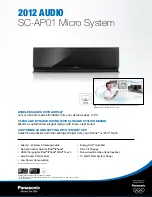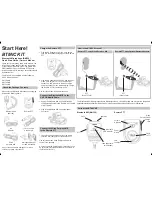
800iX User Manual | 15
14 | 800iX User Manual
8 0 0 i X U s e r M a n u a l
8 0 0 i X U s e r M a n u a l
TROUBLESHOOTING GUIDE
Battery Check
• Confirm
batteries are charged
each night.
• Make
sure the LT-71 is turned off
while charging so that it will attain
a full charge. Full charge will last
eight hours.
• Make
sure the charge cord is
connected to the cradle charger.
• Inspect
the battery contacts. Clean
and adjust if necessary.
Hearing Static
• Ensure
sensor is in optimum
location (refer to sensor placement
in manual). A single sensor will
cover a 1600 sq. ft. enclosed
classroom.
• Ensure
that no other LT71/HM70 is
operating on the same channel.
• If
an external microphone is in use,
try another LightMic that is known
to be working (if available) to isolate
the problem. If static persists with
“known good” microphone, the
LT-71 input jack has damage and
will need service.
Low Volume or Feedback
•
Ensure
microphone is positioned
appropriately, just below the collar
bone. If a headset microphone is in
use, the end of the mic boom
should be positioned at the corner
of the mouth.
• Check
volume level on the receiver.
If the volume is too high, feed-
back WILL occur—adjust accordingly.
No Sound
• Turn
the 800iX on. Confirm that
the POWER light located on the
front panel switch is on.
• Confirm
signal is being received
at the amplifier. The IR signal
light will be lit (red) indicating a
signal is being received.
• Confirm
microphone is function-
ing. Next to the IR signal light is
the AF signal light. This light will
flicker (green) as audio is picked
up by the microphone indicating
activity.
• Ensure
amplifier is operating
properly as a stand alone system.
If you review these instructions and still have questions, write down the serial
number and model number of your system and call LightSPEED Technical Services
at 800.732.8999, 5 a.m. – 5 p.m. Pacific Time.
Note: Most problems are directly related to low battery power. Please run
through the “Battery Check” items first. For remaining troubleshooting,
use known good, fully-charged batteries.
Standard Carrier Frequencies (IR)
2.06/2.54 MHz
Alternative Carrier Frequencies (IR)
3.2/3.7 MHz
Frequency Stability
± 3%
Maximum Deviation
±50 Hz
Dynamic Range
> 73 dB
Signal-to-Noise Ratio
> 73 dB
Frequency Response
100 Hz – 10 kHz
Receiver Type
Superheterodyne
Receiver Sensitivity
6 µV for 60 dB S/N
Image and Spurious Rejection
> 70 dB
Reception Selectivity
40 kHz
Squelching Mute Level
3.2 µV
Sensor Inputs (F-connector)
2 Input (Capability to power 6)
Sensor Short Indicator
Yes
Power Supply (UL Listed)
16 V / 1.0 A
Weight
5.2 lbs.
Dimensions (W x D x H)
17.3 x 8.5 x 1.75
Audio Distortion
< 1 %
Built-in Microphone
Uni-directional Electret
Battery Power (1-year warranty)
2 AA NiMH Rechargeable
Inputs
Mic Level 3.5 mm
Line Level 3.5 mm
Dimensions (W x D x H)
1.375” x .75” x 4.625”
Weight
3.7 oz
Working Range
Up to 1600 square feet
per sensor
Cable
50 ft., Plenum-rated
Mounting
Ceiling clip/Wall bracket
Dimensions
4.25” (Diam.) x 2.0” (H)
Weight
4.5 oz
SYSTEM SPECIFICATIONS
OVERALL SPECIFICATIONS
RECEIVER SPECIFICATIONS
TRANSMITTER SPECIFICATIONS
IR SENSOR SPECIFICATIONS




































